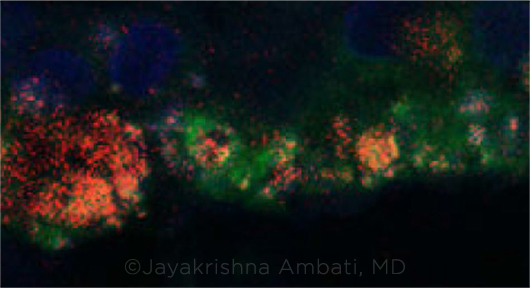Download PDF
Scientists at the University of Virginia have identified “junk” DNA in the cytoplasm of retinal cells as a possible driver of a molecular cascade that leads to geographic atrophy (GA) in patients with age-related macular degeneration (AMD). Furthermore, derivatives of a common anti-AIDS drug, AZT, appear to block the impact of this free-floating DNA and thereby prevent GA lesions from growing, the researchers found.1,2
Known as Alu cDNA, these molecules were present in retinal pigment epithelium (RPE) cells of donor eyes of patients with GA, the researchers said. The Alu cDNA concentrates primarily along the periphery of the GA lesions.
 |
HISTOLOGY. This image shows the Alu cDNA in the RPE at the edge of a GA lesion (red = Alu cDNA; blue = DAPI staining of the nucleus; green = autofluorescence of the RPE cells).
|
Why RPE cells die. In a series of experiments in rodents, the researchers found that the Alu cDNA triggers activation of an inflammasome, NLRP3, which then bathes cells in toxic cytokines.1 This may explain why RPE cells die in patients with dry AMD.
These findings expand on those from an earlier study, in which the researchers published a dogma-toppling conclusion: Contrary to what has long been believed, production of cellular DNA is not always confined inside cell nuclei or mitochondria. Instead, in eyes with GA, small sections of what is usually noncoding Alu RNA are released into the cytoplasm, where they cause production of complementary DNA.2
It is the extraneous Alu cDNA and a consequent release of mitochondrial DNA that trigger an inflammatory response leading to RPE cell degeneration, said study leader Jayakrishna Ambati, MD, at the University of Virginia in Charlottesville. “You have this DNA that’s being made in the cytoplasm. It’s not supposed to be there. So when our body sees that, it turns on many of the same alarm pathways that it turns on when it sees viruses—that is, the inflammasome,” Dr. Ambati said. “What’s evolved as a defense mechanism against pathogens has now been hijacked and turned against our own bodies.”
The AIDS connection. In a study published in 2014, the researchers found that this inflammatory pathway could be blocked by nucleoside reverse transcription inhibitors (NRTIs), which are used to treat HIV infection.3 Thus, they hypothesized that NRTIs might be reducing the incidence of dry AMD in patients who take them as AIDS therapy, Dr. Ambati said.
They then analyzed data from four large, longitudinal health insurance databases and found that the use of NRTIs was associated with a 38% lower risk of GA (pooled adjusted hazard ratio, 0.616; 95% confidence interval, 0.493-0.770).2
Next steps. If an NRTI were to prove effective against GA, it would need to be in a less toxic formulation that does not have the potential serious side effects of antiretroviral drugs, Dr. Ambati said. “Those drugs are toxic from top to toe. Even the safer ones are not that pleasant. And certainly in an elderly population, you would have to be very careful.”
Buoyed by the “natural experiment” they uncovered in the insurance databases, Dr. Ambati said his group hopes to treat GA patients with a modified, less toxic NRTI from the Kamuvudine class in a clinical trial early this year.
—Linda Roach
___________________________
1 Fukuda S et al. Sci Adv. 2021;7(40):eabj3658.
2 Fukuda S et al. Proc Natl Acad Sci. 2021;118(6):e2022751118.
3 Fowler BJ et al. Science. 2014;346(6212):1000-1003.
___________________________
Relevant financial disclosures: Dr. Ambati—Inflammasome Therapeutics: O.
For full disclosures and the disclosure key, see below.
Full Financial Disclosures
Dr. Ambati Allergan: C; Biogen: C; Boehringer-Ingelheim: C; DiceRx: O; iVeena Delivery Systems: O; iVeena Holdings: O; Inflammasome Therapeutics: O; Immunovant: C; Janssen: C; Olix Pharmaceuticals: C; Retinal Solutions: C; Saksin LifeSciences: C; University of Kentucky: P; University of Virginia: P.
Dr. Field None.
Dr. Pearson None.
Dr. Sallam None.
Disclosure Category
|
Code
|
Description
|
| Consultant/Advisor |
C |
Consultant fee, paid advisory boards, or fees for attending a meeting. |
| Employee |
E |
Employed by a commercial company. |
| Speakers bureau |
L |
Lecture fees or honoraria, travel fees or reimbursements when speaking at the invitation of a commercial company. |
| Equity owner |
O |
Equity ownership/stock options in publicly or privately traded firms, excluding mutual funds. |
| Patents/Royalty |
P |
Patents and/or royalties for intellectual property. |
| Grant support |
S |
Grant support or other financial support to the investigator from all sources, including research support from government agencies (e.g., NIH), foundations, device manufacturers, and/or pharmaceutical companies. |
|
More from this month’s News in Review